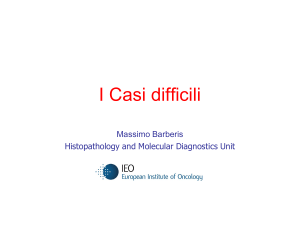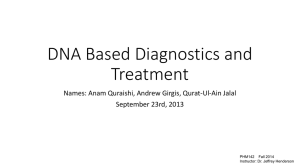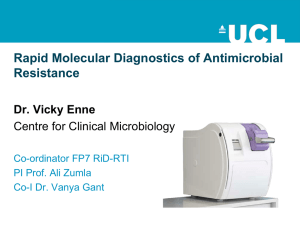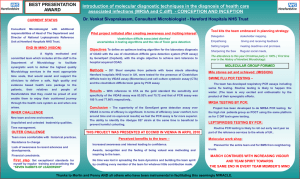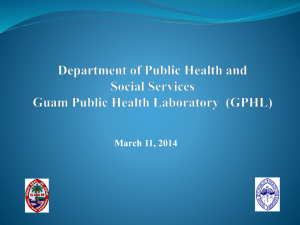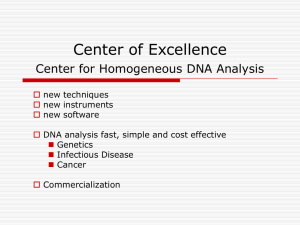Update on Molecular Diagnostics in the Clinical Laboratory
advertisement
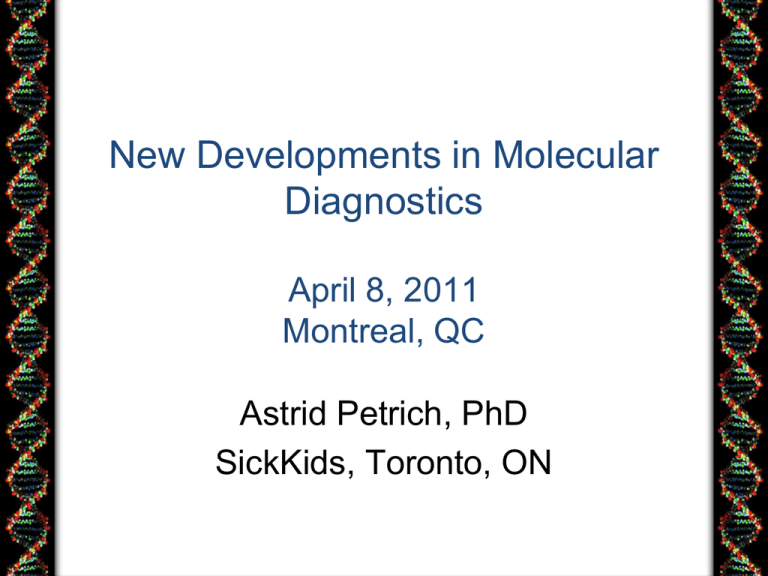
New Developments in Molecular Diagnostics April 8, 2011 Montreal, QC Astrid Petrich, PhD SickKids, Toronto, ON Objectives • To provide an overview of the current state of molecular microbiology diagnostics in Canadian laboratories. • To review some of the factors involved with laboratories offering new molecular assays in microbiology. • To discuss some of the new developments in technology and instrumentation in molecular microbiology diagnostics. Disclosures • I have tried many of the instruments and kits over the years • No financial arrangements • No contracts • Some on-going evaluations for which I have received free kits (artus, Seegene) Outline • • • • • • • Where are we with molecular diagnostics? Extraction Real-time Multiplexing Systems that do it all Sequencing The new and wonderful? – Or I wish we could have one of those. What do most of us have? • A thermal cycler (old school, conventional, block PCR) • Molecular method for CT/GC detection • Real-time PCR instrument – Older versions – Newer versions • Automated or semi-automated extraction • Access to sequencing (send-out), if not doing onsite Assays many of us are using • • • • • CT/GC MRSA VRE HSV, Enterovirus in CSF FluA (other respiratory) Assays some of us are doing • Transplant screening and monitoring – CMV, EBV, BK, Adenovirus • HPV • B. pertussis • WNV • HepC, HepB • HIV • Norovirus • 16s PCR plus sequencing • C. difficile Assays we would like to do • Everything • More multiplexes for “disease states” – Respiratory – Gastro – Encephalitis – Transplant • Resistance beyond Some of the reasons we don’t • • • • Cost of the test Cost of the instrumentation Trained staff Commercially available assays – Health Canada approved • Sensitivity – Add on test, still need to do culture • What do we do with the results? Pre-Analytical • Quality of sample • Sample type • Few changes in the last 20 years • One exception-Flocked swab for respiratory and other specimens • Should we be spending more time on this? Extraction • Most important part of analysis? • Quantity, Quality • Lack of inhibitors • Complete lysis of cells • RNA, DNA, both • Throughput • Different methods for different sample types • Hands-on time • Expertise Extraction Nucleic Acid Extraction • Semi-automated • Automated • Instruments with kits – EZmag (bioMérieux) – M48, MDX, (Qiagen) – MagNA Pure LC (Roche) • Kits with generic instruments Extraction Thermal cyclers • Faster • More compact • More features (gradients) • Cheaper • Other options for detection Real-time • significant improvements in the diagnosis of infectious disease. • Increased sensitivity and specifity • Increased speed • Allows multiplexing • Greatest impact is probably its use for the quantitation of target organisms in samples. • six orders of magnitude • closed-tube format removes need for postamplification manipulation reduces risk of contamination • Costs more (reagents and instrumentation) Real-time NAAT instruments • LightCycler 1.5, 2.0 • ABI 7700 • Smartcycler (Cepheid) Newer – Corbett Rotorgene 6000 – LightCycler 480, LightCycler 1536 – Stratagene: Mx4000, Mx3000P, Mx3005P – Applied Biosystems: ABI 7300, ABI 7500, ABI 7500 Fast, ABI 7900 Fast HT with automation accessory, ABI StepOne – Eppendorf: Mastercycler ep realplex – BioRad: MiniOpticon, MyiQ, Opticon2, Chromo4, iQ5 Good comparison of features of Real-time instruments http://www.horizonpress.com/pcr/qPCR-machines.html Quantitation • Monitoring of transplant patients – CMV, EBV, BK, Adenovirus? • Efficacy of treatment • Prognosis • Resistance • Standardization? • QA • Other agents? – FluA Self-collected influenza H1N1 viral loads: Influenza viral load (copies/mL) 100000000 10000000 1000000 100000 Patient 1 10000 Patient 2 Patient 3 1000 100 10 1 1 2 3 4 5 6 7 8 Days from symptom onset Smieja, Petrich, Mahony et al. [Late-breaker] International Congress of Chemotherapy and Infections, Toronto June 2009 High Resolution Melt • SNP analysis • Identification • Resistance Systems that do it all for you • From sample extraction • to amplification • to detection Gen-Probe • Tigris DTS • Soon to lauch-Panther for low to medium throughput laboratories Tigris DTS • Target capture magnetic bead • No opening of tubes • Aptima kits – CT/GC – T. vaginalis – HPV – HIV-1 – HepC • 3.5 hrs for first results • 100 samples every 3 hrs following first results Roche Diagnostics AmpliPrep • Automates the sample extraction process • Bar coded reagents packaged in ready-to-use spillproof cassettes with self-sealing caps for increased stability • Up to 72 samples and 4 different assays can be loaded onto the system at the same time • Works in combination with the COBAS® TaqMan® 48 Analyzer, COBAS® TaqMan® Analyzer or Amplicor Analyzer to automate sample preparation, amplification, and quantitation of RNA or DNA Roche (COBAS®) TaqMan® Analyzer • • • • • • • Automated and fully docked systems available with COBAS® AmpliPrep/COBAS® TaqMan® HIV-1, HCV, and HBV tests 96-test capacity 4 independently controlled thermal cyclers Amplifies and detects RNA and DNA within hours Quantitation standard and closed-tube format Reduces the risk of sample contamination, optimizes workflow Assays-HIV-1 (quant and qual), HCV, HBV AMPLICOR Analyzer • • • • Bar-coded data entry 48 sample capacity per run Test-specific reagents Multiplexing- up to 6 detections per amplified sample • Assays-HIV-1, CMV, CT/GC, HCV Roche (COBAS®) TaqMan® 48 Analyzer • • • • • • • Two thermal cyclers can run independent PCR profiles simultaneously One platform separately configurable to run IVD assays and up to 10 user-defined applications Amplifies and detects RNA and DNA within hours Requires no user interaction after sample loading completed Optimizes workflow, minimizes contamination Small, compact footprint 48 samples at a time Qiagen • • • • • • QIAsymphony RGQ®, an automated system for molecular testing, process a range of sample types composed of modules that can be used as stand-alone systems or combined into a fully integrated system. QIAsymphony SP for sample preparation QIAsymphony AS for assay setup Rotor-Gene® Q real-time PCR thermocycler. BD Diagnostics • • • • BD Max The new BD MAX™ fully-automated open molecular biology platform allowing multiple specimen types and assays simultaneously. The Jaguar™ platform, initially developed by HandyLab, commercialised by BD as the BD MAX™ system BD • • • • Reagent strips for 1 to 24 samples per run Microfluidic real-time PCR Up to 144 tests per day (38 000 tests a year) Extraction from multiple specimen types (blood, urine, swabs, etc.) • Ability to run multiple tests simultaneously (e.g. testing for S. aureus and Group B Streptotoccus at the same time) • 45 minutes to 2 hours, depending on the number of samples analysed Abbott Diagnostics M2000 • Real-time PCR Amplification and Detection • 5 excitation, 5 emission filters • maxRatio Data Analysis • M2000sp • M2000rt Abbott • • • • • • • • • • • • • • • RealTime HIV-1 RealTime HCV RealTime HCV Genotype II RealTime HBV RealTime High Risk HPV RealTime CT/NG RealTime CT RealTime CMV RealTime HIV-1 Qualitative Parvo B19 PCR Kit HSV 1/2 PCR Kit VZV PCR Kit EBV PCR Kit M. tuberculosis SARS RT-PCR Kit • Barcoded Laboratory Tubes • Open Mode • Flexible protocol for various sample types and volumes • 24 to 96 samples Multiplexing • New technologies have allowed for multiplexing with minimal loss of sensitivity • Seegene (Alere) • xTag (Luminex) • Multicode (Eragen) • ResPlex (Qiagen) Xtag Lumionex • RVP respiratory panel • In development – Gastrointestinal panel – Fungal panel Eragen • Multicode RTx HSV 1 and 2 • MultiCode-RTx System Neisseria gonorrhoeae • Others in development ResPlex(Qiagen) • ResPlex 1 bacterial pathogens and adenovirus • ResPlex 2 viral pathogens • Others in development Seegene (Alere) • • • • • • Respiratory panels Gastrointestinal panels Meningitis panels STI panels HPV Mycobacteria panels Multiplexing and Quantitation PrimeraDx • Multiplex PCR with continuous sampling and separation by capillary electrophoresis • Herpesviruses • C. difficile • Respiratory viruses • Others in development • Cost! MALDI-TOF Mass Spectrometry Matrix-assisted laser desorption/ionization (MALDI) • Soft ionization technique • Allows analysis of biomolecules which fragment when ionized i • Matrix solution is mixed with the analyte (e.g. whole cells) on a MALDI analysis plate • Solvent is added to the sample resulting into a recrystallized matrix with analyte molecules spread throughout the crystals. • A current is generated resulting in movement of the fragmented biomolecules towards a detector based on size smaller molecules move faster) • A pattern is generated based on the size and number of molecules • MALDI/TOF spectra are used for the identification of microorganisms such as bacteria or fungi. • A colony of the microbe in question is smeared directly onto a dry plate (96 wells), overlayed with matrix • Mass spectra generated are analyzed by dedicated software and compared with stored profiles. • 96 wells in 40 mins. • Species diagnosis by this procedure is faster, more accurate and cheaper than immunological or biochemical tests. Representative mass spectral outputs H. N. Shah, As published in CLI November 2005 Representative mass spectral outputs H. N. Shah, As published in CLI November 2005 Concordance between Conventional Routine Identification (Vitek; bioMérieux) and Matrix-Assisted Laser Desorption Ionization Time-of-Flight (MALDI-TOF) Mass Spectrometry Identification (Brucker Mass Spectrometer and Database Complemented with Local Database). Seng P et al. Clin Infect Dis. 2009;49:543-551 © 2009 by the Infectious Diseases Society of America Sequencing • Applications – ID of known organisms • Cultured isolates • Sterile body fluids – Typing – Resistance detection Sanger sequencing Sanger Sequencing • • • • Expensive Hands on time 500-700 bases per run Overnight? Sequencing for ID • Does my ID give me the same ID as your ID? • Cultured isolate vs. clinical specimen? • What are you sequencing? -16S rDNA -HSP genes? -whole genome? • What will the changes be to taxonomy • What does it mean if it is not a recognized pathogen • What about contaminating nucleic acid? Pyrosequencing Pyromark Q24 • PCR product of interest • Up to 24 samples can be prepared in parallel using Vacuum Workstation (~15 mins) to clean up PCR product. • Two formats-preprogramed sequence of nucleotide presented vs. sequential addition (G-AT-C)n • High Volume instrument also available Pyromark Q96 • Real time addition and viewing of results • 50-100 bases added High through-put • Genome sequencing? • Sequence of all data and pulling out important? Sequencing Workflow Sample input: Genomic DNA, BACs, amplicons, cDNAGeneration of small DNA fragments via Nebulization Ligation of A/B-Adaptors flanking singlestranded DNA fragments Emulsification of beads and fragments in water-in-oil microreactors Clonal amplification of fragments bound to beads in microreactors Sequencing and base calling (400,000 reads per run) High-throughput Sequencing Plex-ID (Abbott Diagnostics) IBIS • The coupling of broad PCR amplification with electrospray Time-of-flight Mass Spectrometry (ESI – TOF – MS) • Post PCR amplicons are measured with accurate mass to determine their unique base compositions and compared against a database of known targets • Rapid and sensitive identification of known, unknown, and emerging microorganisms without culture. • Broad identification Bacteria, Viruses, Fungi, Protozoa • High resolution genotyping and strain identification • Detects complex mixtures of microbes Expected and unexpected microbes in a single test • Rapid detection – no culture required Detection and identification in < 1 shift (6-8 hrs) • Determine drug resistance and virulence IBIS workflow • Extract nucleic acid from sample • Amplify nucleic acids to measure • Use broad-range, unbiased PCR primers (conserved universal areas with variable regions in between) • Analyze nucleic acid using mass spec • Identify the organism using base recognition fingerprints • Eight hours start to finish Analysis Really neat stuff with huge potential • • • • Macro and microarrays Microfluidics Sequencing New identification methods What does the future hold? • More automation • More clinical interpretation – What does it mean to have that virus/bacteria/fungi in that specimen? – What does that mutation mean for resistance/pathogenicity? • More research into correlating what we find with clinical information • More bioinformatics
